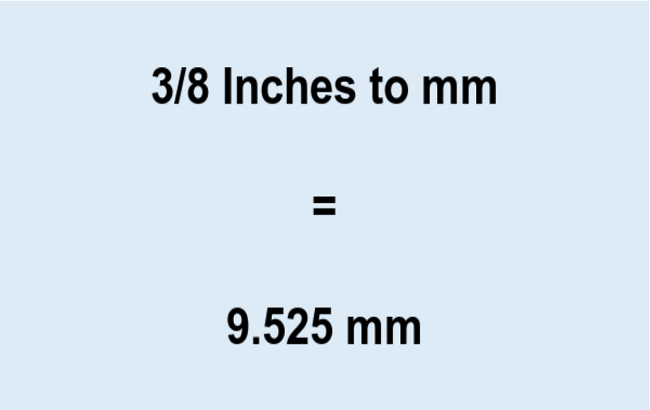If you’ve ever wondered about the conversion from 3/8 to mm, you’re not alone. Understanding this simple yet significant conversion can be surprisingly impactful, especially in fields like construction, automotive repair, and home improvement. This article will cover five shocking facts about converting 3/8 to mm that every Canadian should know, ensuring you’re well-informed for all your measurement needs.
What Does 3/8 to mm Mean?
At its core, 3/8 to mm refers to converting a fraction of an inch into millimeters. Inches are commonly used in Canada alongside the metric system, so knowing how to switch between the two is essential.
- Quick Conversion: 3/8 inch equals 9.525 mm.
- Why It Matters: Precise measurements ensure accuracy in projects, whether you’re cutting wood, fixing machinery, or crafting something intricate.
How Is 3/8 to mm Calculated?
Here’s a simple breakdown:
- Understand the ratio: 1 inch = 25.4 mm.
- Convert the fraction: 3/8 = 0.375.
- Multiply: 0.375 × 25.4 = 9.525 mm.
This straightforward calculation saves time and avoids costly errors.
1. The Metric System vs. Imperial System
Canada officially uses the metric system but often accommodates the imperial system for practical reasons. This dual usage can confuse conversions like 3/8 to mm. Let’s explore why:
- Metric Advantages:
- Easier calculations due to decimal-based increments.
- Universally recognized, making international projects seamless.
- Imperial Persistence:
- Deeply rooted in industries like construction and woodworking.
- Common in tools, blueprints, and product specifications.
Knowing how to convert 3/8 to mm bridges this gap, ensuring smooth collaboration across systems.
2. Everyday Uses for 3/8 to mm Conversions
Conversions like 3/8 to mm might seem trivial, but they’re vital in everyday tasks. Here are some examples:
- DIY Projects:
- Hanging shelves or assembling furniture often requires precise measurements.
- Automotive Repairs:
- Many bolts and screws in cars are specified in fractions of an inch.
- Plumbing Work:
- Pipe sizes can vary between imperial and metric units.
By mastering 3/8 to mm, you’ll avoid frustration and save valuable time.
3. Surprising Origins of Measurement Systems
Did you know the imperial system originated in England during the 19th century? In contrast, the metric system was developed in France in the late 18th century as part of a push for universal standards. Canada’s adoption of the metric system in 1970 led to dual-system practices, making conversions like 3/8 to mm essential.
Why It Matters Today
- Global Trade:
- Companies rely on conversions for importing and exporting goods.
- Education:
- Schools teach both systems, preparing students for diverse careers.
- Practicality:
- Tools and materials often display measurements in both formats.
4. Tools for Accurate 3/8 to mm Conversion
While manual calculations work, technology simplifies the process. Here are some tools I recommend:
- Digital Calipers:
- Instantly switch between imperial and metric measurements.
- Online Calculators:
- Many websites provide instant conversions.
- Smartphone Apps:
- Apps like Unit Converter Pro make quick work of conversions.
Tips for Reliable Measurements
- Double-check your conversions.
- Use quality tools to reduce errors.
- Keep a reference chart handy.
5. Shocking Facts About 3/8 to mm Conversion
Here are five unexpected insights about 3/8 to mm that might surprise you:
- Universal Application:
- From kitchen recipes to engineering designs, this conversion pops up in countless places.
- Cost-Saving Precision:
- Accurate measurements reduce material waste and prevent expensive mistakes.
- Historical Legacy:
- The imperial system’s continued use in Canada keeps this conversion relevant.
- DIY Revolution:
- Online tutorials often use imperial measurements, making conversions crucial for Canadians.
- Global Relevance:
- Travel or trade? You’ll likely encounter the need to convert measurements.
How 3/8 to mm Impacts Canadians
Understanding 3/8 to mm isn’t just about numbers. It’s about:
- Practicality: Ensuring your tools and materials align with project specifications.
- Efficiency: Saving time by avoiding mismatches and recalculations.
- Adaptability: Preparing for international work or personal tasks that require conversions.
Many Canadians, from hobbyists to professionals, benefit from mastering this skill. Whether you’re a DIY enthusiast or an engineer, precise conversions enhance your outcomes.
Resources for Mastering Conversions
To build your confidence in converting 3/8 to mm, explore these helpful links and resources:
- Metric vs. Imperial System Explained
- Practical Measurement Tips
- 1.5f8-p1uzt: A Comprehensive Guide – Learn about unique measurements like 1.5f8-p1uzt and their uses.
FAQs: Your Questions About 3/8 to mm Answered
Q: What is 3/8 to mm in decimal form? A: 3/8 inch converts to exactly 9.525 mm.
Q: Why does Canada use both metric and imperial systems? A: Canada adopted the metric system in the 1970s but retained imperial for practical reasons in certain industries.
Q: How can I ensure accurate conversions? A: Use tools like digital calipers, reference charts, or conversion apps for precision.
Q: Are there any standard charts for common conversions? A: Yes, many online platforms offer free conversion charts for quick reference.
Q: Is converting 3/8 to mm necessary for daily life? A: Absolutely! It’s handy for DIY, construction, and professional tasks.
Conclusion
Understanding how to convert 3/8 to mm empowers Canadians to navigate measurements confidently. From DIY projects to professional applications, this knowledge bridges the gap between imperial and metric systems. With tools, tips, and historical insights, you’ll never be caught off guard by this seemingly simple yet crucial conversion. Remember, 3/8 inch equals 9.525 mm—a fact that can save time, money, and effort!




